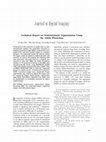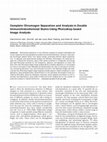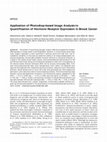Papers by Gessyca Vanderlei Cavalcanti
Chinese Journal of …, Jan 1, 2005
A method for measuring leaf area was developed using digital camera and Photoshop software.The me... more A method for measuring leaf area was developed using digital camera and Photoshop software.The measured data from digital camera was compared with the values from paper-cut and instrumental scanning methods and etc.The results showed that there was highly ...

Journal of Digital Imaging, Jan 1, 2005
The purpose of this research is to enable users to semiautomatically segment the anatomical struc... more The purpose of this research is to enable users to semiautomatically segment the anatomical structures in magnetic resonance images (MRIs), computerized tomographs (CTs), and other medical images on a personal computer. The segmented images are used for making 3D images, which are helpful to medical education and research. To achieve this purpose, the following trials were performed. The entire body of a volunteer was scanned to make 557 MRIs. On Adobe Photoshop, contours of 19 anatomical structures in the MRIs were semiautomatically drawn using MAGNETIC LASSO TOOL and manually corrected using either LASSO TOOL or DIRECT SELECTION TOOL to make 557 segmented images. In a similar manner, 13 anatomical structures in 8,590 anatomical images were segmented. Proper segmentation was verified by making 3D images from the segmented images. Semiautomatic segmentation using Adobe Photoshop is expected to be widely used for segmentation of anatomical structures in various medical images.

Microcirculation, Jan 1, 2000
Study end-points in microcirculation research are usually video-taped images rather than numeric ... more Study end-points in microcirculation research are usually video-taped images rather than numeric computer print-outs. Analysis of these video-taped images for the quantification of microcirculatory parameters usually requires computer-based image analysis systems. Most software programs for image analysis are custom-made, expensive, and limited in their applicability to selected parameters and study end-points. We demonstrate herein that an inexpensive, commercially available computer software (Adobe Photoshop), run on a Macintosh G3 computer with inbuilt graphic capture board provides versatile, easy to use tools for the quantification of digitized video images. Using images obtained by intravital fluorescence microscopy from the pre- and postischemic muscle microcirculation in the skinfold chamber model in hamsters, Photoshop allows simple and rapid quantification (i) of microvessel diameters, (ii) of the functional capillary density and (iii) of postischemic leakage of FITC-labeled high molecular weight dextran from postcapillary venules. We present evidence of the technical accuracy of the software tools and of a high degree of interobserver reliability. Inexpensive commercially available imaging programs (i.e., Adobe Photoshop) provide versatile tools for image analysis with a wide range of potential applications in microcirculation research.
Journal of …, Jan 1, 2004
Background: The precise quantification of fibrous tissue in liver biopsy sections is extremely im... more Background: The precise quantification of fibrous tissue in liver biopsy sections is extremely important in the classification, diagnosis and grading of chronic liver disease, as well as in evaluating the response to antifibrotic therapy. Because the recently described methods of digital image analysis of fibrosis in liver biopsy sections have major flaws, including the use of out-dated techniques in image processing, inadequate precision and inability to detect and quantify perisinusoidal fibrosis, we developed a new technique in computerized image analysis of liver biopsy sections based on Adobe Photoshop software.
San Jose, CA: Adobe Systems, Jan 1, 2000
Journal of Histochemistry …, Jan 1, 2000
Currently available techniques for performing quantitative immunohistochemistry (Q-IHC) rely upon... more Currently available techniques for performing quantitative immunohistochemistry (Q-IHC) rely upon pixel-counting algorithms and therefore cannot provide information as to the absolute amount of chromogen present. We describe a novel algorithm for true Q-IHC based on calculating the cumulative signal strength, or energy, of the digital file representing any portion of an image. This algorithm involves subtracting the energy of the digital file encoding the control image (i.e., not exposed to antibody) from that of the experimental image (i.e., antibody-treated). In this manner, the absolute amount of antibody-specific chromogen per pixel can be determined for any cellular region or structure. (J Histochem Cytochem 48:303-311, 2000)

… of Histochemistry & …, Jan 1, 1999
Simultaneous detection of two different antigens on paraffin-embedded and frozen tissues can be a... more Simultaneous detection of two different antigens on paraffin-embedded and frozen tissues can be accomplished by double immunohistochemistry. However, many double chromogen systems suffer from signal overlap, precluding definite signal quantification. To separate and quantitatively analyze the different chromogens, we imported images into a Macintosh computer using a CCD camera attached to a diagnostic microscope and used Photoshop software for the recognition, selection, and separation of colors. We show here that Photoshop-based image analysis allows complete separation of chromogens not only on the basis of their RGB spectral characteristics, but also on the basis of information concerning saturation, hue, and luminosity intrinsic to the digitized images. We demonstrate that Photoshop-based image analysis provides superior results compared to color separation using bandpass filters. Quantification of the individual chromogens is then provided by Photoshop using the Histogram command, which supplies information on the luminosity (corresponding to gray levels of black-and-white images) and on the number of pixels as a measure of spatial distribution. (J Histochem Cytochem 47:119-125, 1999)

… of Histochemistry & …, Jan 1, 1997
The benefit of quantifying estrogen receptor (ER) and progesterone receptor (PR) expression in br... more The benefit of quantifying estrogen receptor (ER) and progesterone receptor (PR) expression in breast cancer is well established. However, in routine breast cancer diagnosis, receptor expression is often quantified in arbitrary scores with high inter-and intraobserver variability. In this study we tested the validity of an image analysis system employing inexpensive, commercially available computer software on a personal computer. In a series of 28 invasive ductal breast cancers, immunohistochemical determinations of ER and PR were performed, along with biochemical analyses on fresh tumor homogenates, by the dextran-coated charcoal technique (DCC) and by enzyme immunoassay (EIA). From each immunohistochemical slide, three representative tumor fields ( ϫ 20 objective) were captured and digitized with a Macintosh personal computer. Using the tools of Photoshop software, optical density plots of tumor cell nuclei were generated and, after background subtraction, were used as an index of immunostaining intensity. This immunostaining index showed a strong semilogarithmic correlation with biochemical receptor assessments of ER (DCC, r ϭ 0.70, p Ͻ 0.001; EIA, r ϭ 0.76, p Ͻ 0.001) and even better of PR (DCC, r ϭ 0.86; p Ͻ 0.01; EIA, r ϭ 0.80, p Ͻ 0.001). A strong linear correlation of ER and PR quantification was also seen between DCC and EIA techniques (ER, r ϭ 0.62, p Ͻ 0.001; PR, r ϭ 0.92, p Ͻ 0.001). This study demonstrates that a simple, inexpensive, commercially available software program can be accurately applied to the quantification of immunohistochemical hormone receptor studies. (J Histochem Cytochem 45:1559-1565, 1997)











Uploads
Papers by Gessyca Vanderlei Cavalcanti